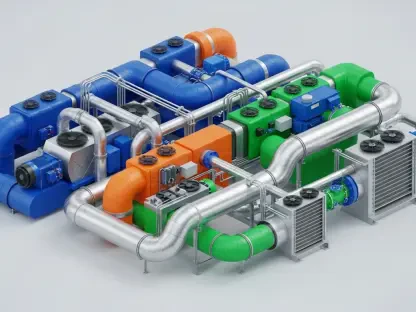The global bromine market is witnessing an extraordinary wave of growth, propelled by its indispensable role in a wide array of industries, from enhancing fire safety in electronics to supporting critical operations in oil and gas drilling. This halogen element, primarily extracted from brine reserves, is a cornerstone of modern industrial applications, with its market value projected to climb from $1.94 billion in 2024 to an impressive $3.3 billion by 2034. Achieving a steady compound annual growth rate (CAGR) of 5.5% over this period, the industry demonstrates both resilience and potential, even as it faces evolving regulatory landscapes and economic challenges. This article aims to explore the intricate dynamics driving this expansion, delving into the diverse applications that fuel demand, the regional variations shaping opportunities, and the innovative trends steering the market toward sustainability. Designed to inform stakeholders, investors, and industry leaders, the following analysis offers a comprehensive look at what lies ahead for bromine over the next decade, highlighting key factors that will influence its trajectory in a rapidly changing global environment.
Unveiling Market Growth Potential
The bromine market is on a promising upward path, with forecasts indicating a rise to $3.3 billion by 2034 from a starting point of $1.94 billion in 2024. This growth, marked by a consistent 5.5% CAGR, reflects strong demand across critical sectors such as flame retardants, water treatment, and oil and gas drilling. These industries rely heavily on bromine for safety enhancements and operational efficiency, underscoring its pivotal role in meeting modern industrial needs. The steady expansion signals a robust market outlook, even amidst external pressures like regulatory changes and geopolitical uncertainties. For stakeholders, this trajectory presents a clear opportunity to invest in a sector with proven resilience and long-term value, provided they remain attuned to the evolving landscape.
Beyond the numbers, this growth story is underpinned by bromine’s adaptability to diverse industrial challenges. Its applications not only address immediate safety and performance requirements but also align with broader global trends toward environmental management and technological advancement. The market’s ability to maintain a consistent growth rate suggests a deep-rooted demand that transcends short-term economic fluctuations. As industries worldwide continue to prioritize stringent safety standards and sustainable practices, bromine’s relevance is expected to deepen, offering a stable foundation for future investments. Companies and policymakers alike must recognize this potential and strategize accordingly to harness the benefits of this expanding market over the coming years.
Exploring Diverse Industrial Applications
Bromine’s strength in the global market lies in its remarkable versatility across a spectrum of industrial uses, making it a vital component in numerous high-demand sectors. One of the most prominent applications is in flame retardants, where compounds like tetrabromobisphenol-A are essential for ensuring fire safety in electronics, construction materials, and automotive components. This role is particularly critical as safety regulations tighten globally, driving consistent demand for bromine-based solutions that protect lives and property. Additionally, its significance extends to the oil and gas industry, where derivatives such as calcium bromide are integral to drilling fluids, aiding in well stabilization under extreme conditions. This broad applicability ensures that bromine remains a linchpin in industrial innovation and safety.
Further expanding its footprint, bromine plays a crucial role in water treatment, pharmaceuticals, and agricultural chemicals, addressing a wide range of societal and environmental needs. In water treatment, it serves as an effective agent for purification, ensuring safe and clean resources in both industrial and municipal settings. Meanwhile, in pharmaceuticals, bromine acts as a key intermediate in the synthesis of various drugs, contributing to advancements in healthcare. Its use in agricultural chemicals also supports sustainable farming practices by aiding in pest control and crop protection. This diversity in application not only bolsters market demand but also highlights bromine’s adaptability to emerging challenges, positioning it as an essential element in shaping a safer and more sustainable industrial landscape for the future.
Navigating Regional Market Dynamics
The bromine market exhibits significant regional variations, with Asia-Pacific standing out as the dominant force due to its rapid industrialization and favorable regulatory environment. Countries like China and India are at the forefront, experiencing a surge in demand driven by expanding manufacturing sectors and increasing adoption of bromine-based products in safety and performance applications. This region’s growth is further fueled by supportive policies that encourage industrial development, making it a prime destination for market expansion and investment. For global players, understanding the nuances of Asia-Pacific’s economic and industrial landscape is essential to capitalize on the abundant opportunities it presents over the forecast period.
In contrast, North America and Europe contribute to the market with their own distinct priorities and challenges, shaped by stricter environmental regulations and a focus on sustainability. The U.S. market, for instance, heavily relies on bromine for enhancing safety across electronics and oil drilling operations, maintaining a steady demand despite regulatory constraints. Europe, on the other hand, is pushing the envelope on sustainable practices, with an emphasis on developing eco-friendly bromine derivatives to comply with stringent environmental laws. These regional differences underscore the importance of tailored strategies that address local policies, consumer behaviors, and industrial needs. By aligning approaches with specific regional dynamics, companies can effectively navigate challenges and unlock growth potential in diverse markets worldwide.
Embracing Sustainability and Innovation
A defining trend in the bromine market is the growing emphasis on sustainability, as industries worldwide pivot toward eco-friendly solutions to meet global environmental standards. Innovations in bromine recycling and the development of greener flame retardants are gaining momentum, addressing long-standing ecological concerns associated with certain brominated compounds. These advancements are not merely responses to regulatory pressures but also strategic moves to enhance the market’s long-term viability and appeal to environmentally conscious consumers. As sustainability becomes a core driver of industrial decision-making, bromine’s role in supporting green initiatives is poised to strengthen, offering a competitive edge to forward-thinking companies.
Equally important is the role of research and development in propelling the market into new frontiers of efficiency and application. Significant investments are being channeled into exploring novel uses for bromine and refining production processes to reduce costs and environmental impact. Such efforts are crucial for maintaining competitiveness in a landscape where technological advancement dictates market leadership. Companies that prioritize innovation are better equipped to adapt to shifting demands, whether by developing alternative compounds or enhancing existing products for greater efficacy. This focus on cutting-edge solutions signals a proactive approach, ensuring that the bromine market remains dynamic and relevant in an era increasingly defined by sustainability and technological progress.
Charting Future Pathways for Growth
Reflecting on the bromine market’s journey, the sector demonstrated remarkable resilience and adaptability in reaching a valuation of $1.94 billion by 2024. Its consistent growth, driven by critical applications in flame retardants, oil and gas, and water treatment, showcased the industry’s ability to meet diverse industrial demands. The regional dominance of Asia-Pacific, alongside significant contributions from North America and Europe, painted a picture of a globally interconnected market navigating unique challenges and opportunities. Moreover, the push toward sustainability and innovation marked a pivotal shift, as stakeholders responded to environmental concerns with groundbreaking solutions that balanced compliance with progress.
Looking ahead, the path to achieving a $3.3 billion valuation by 2034 calls for strategic action and collaboration across the industry. Stakeholders should prioritize sustained investment in research and development to uncover new applications and improve production efficiencies, ensuring bromine’s relevance in emerging sectors. Additionally, aligning with regional regulatory frameworks and market needs will be key to unlocking growth in diverse geographies. Embracing partnerships and exploring merger opportunities can further strengthen market positions, while a continued focus on eco-friendly practices will solidify bromine’s standing in a sustainability-driven world. These steps, taken collectively, offer a roadmap for navigating the complexities ahead and harnessing the full potential of this vital industrial element.









